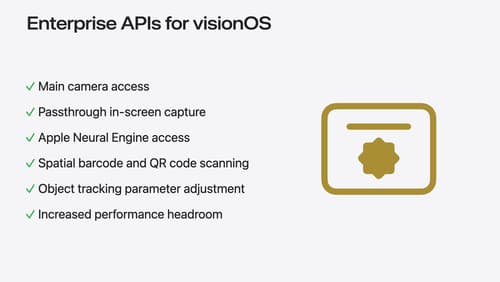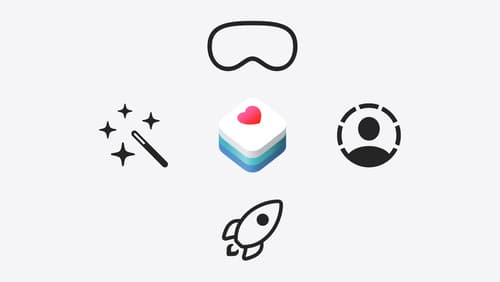How do I get started with Vision Pro?
Asked on 2024-07-16
113 searches
To get started with Vision Pro, you can follow several steps and explore various resources provided by Apple at WWDC. Here are some key points and sessions to help you begin:
-
Device Management:
- Vision Pro uses the same familiar device management and infrastructure as iPhone and iPad. You can manage Vision Pro using device enrollment or user enrollment by signing in with a managed Apple account. For more details, check out the session What’s new in device management.
-
Inspect and Debug:
- To inspect and debug web content on Vision Pro, ensure your Mac and Vision Pro are on the same network. Enable Web Inspector on Vision Pro and connect it to your Mac via Safari's Develop menu. For a detailed guide, refer to the session Optimize for the spatial web.
-
Enterprise APIs:
- Apple has introduced new enterprise APIs for Vision Pro to support various enterprise environments, enhancing collaboration, communication, and productivity. Learn more in the session Introducing enterprise APIs for visionOS.
-
HealthKit Integration:
- Vision Pro supports HealthKit, allowing you to create immersive health experiences. You can reflect on your activities and save data to HealthKit in a distraction-free environment. For more information, see the session Get started with HealthKit in visionOS.
-
Design Interactive Experiences:
- When designing for Vision Pro, consider how to set the stage for your experience and immerse users in new worlds. Utilize features like scene understanding and head position to place content effectively. For design tips, watch the session Design interactive experiences for visionOS.
-
Platforms State of the Union:
- This session provides an overview of the latest features in visionOS, including scene understanding, room anchors, and object tracking. It also highlights the enthusiasm from the developer community and the rapid growth of apps on the App Store. Check out the session Platforms State of the Union for more insights.
By exploring these sessions, you can gain a comprehensive understanding of how to get started with Vision Pro and leverage its capabilities for your projects.

Optimize for the spatial web
Discover how to make the most of visionOS capabilities on the web. Explore recent updates like improvements to selection highlighting, and the ability to present spatial photos and panorama images in fullscreen. Learn to take advantage of existing web standards for dictation and text-to-speech with WebSpeech, spatial soundscapes with WebAudio, and immersive experiences with WebXR.

Introducing enterprise APIs for visionOS
Find out how you can use new enterprise APIs for visionOS to create spatial experiences that enhance employee and customer productivity on Apple Vision Pro.

Get started with HealthKit in visionOS
Discover how to use HealthKit to create experiences that take full advantage of the spatial canvas. Learn the capabilities of HealthKit on the platform, find out how to bring an existing iPadOS app to visionOS, and explore the special considerations governing HealthKit during a Guest User session. You’ll also learn ways to use SwiftUI, Swift Charts, and Swift concurrency to craft innovative experiences with HealthKit.
